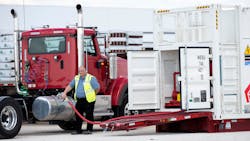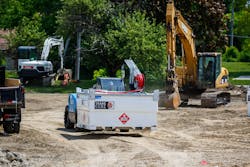Comparing benefits of onsite fuel tanks to wet hosing
Implementing solutions for customers can be a complicated task. Internally, one must consider budgets, strict revenue goals, and sales marks to hit. On the other side, it’s equally crucial to maintain customer relationships. It’s a delicate balance that can be said of many industries and is particularly evident in fuel distribution and the relationship between wet hosing and onsite bulk fuel tanks.
It’s critical to educate customers on alternative methods and the pros of bulk fuel storage when they request wet hosing operations. Distributors must balance what customers need with their own budgets regarding fleet and personnel. Deciding the proper service and informing customers can expand profits and save on budget while ensuring customers are satisfied.
Hurdles in wet hosing
Sometimes called wheel-to-wheel fueling, wet hosing can be labor intensive and expensive. Drivers require Hazmat-endorsement and a CDL. The service is often demanded at night when equipment on the site is not working or the trucks won’t be in the way of day-to-day operations, so refueling can take all night. With 50 large fleet customers, wet hosing likely requires 50 separate drivers and trucks, resulting in a considerable amount of overhead and budgeting difficulties. Because of the demands of the job, there’s often a high turnover rate of these drivers.
The potential of missed deliveries poses another challenge with wet hosing. Wet hosing relies on people, consistency and a keen focus on logistics and scheduling—all things prone to mistakes. Underestimating fill times and overscheduling a driver is easy to do, as is accidentally missing a stop on a busy night. Drivers call in sick and equipment breaks down, making the potential for a missed delivery and an unhappy customer even more possible and costly. If a refrigerated truck goes down, it can result in the costly loss of a truck full of product and claims against the distributor. At the very least, such an error could result in a lost contract. So even though wet hosing appears at first glance to be a great way to boost profits with value added service and additional drop fees, a hard look at the numbers and headaches associated quickly indicates some serious evaluation of contracts is necessary.
With new technology and equipment, fuel distributors can capitalize on the applications that truly require wet hosing service while efficiently and effectively serving most of their customer base with onsite tanks that allow customers to take responsibility for their own fueling demands.
Deciding when wet hosing is essential
Wet hosing often offers the preferred option for customers in cities and jurisdictions with rigid regulations regarding above-ground fuel tanks. In these instances, the number of tanks available to meet the strict codes are very limited and wet hosing is often the most practical solution. While convenient for the customer, wet hosing presents an array of challenges for the fuel distributor. By integrating an onsite tank and wet hosing strategy—reserving wet hosing for those applications that strictly demand it—fuel distributors can best utilize their resources and efficiently service all customer needs.
Many customers look to wet hosing as a solution for theft prevention, accurate fuel tracking and budget forecasting. Because the distributor always maintains control of the fuel, the chances of theft are virtually eliminated, and fleet managers receive a detailed report of how much fuel went into each piece of equipment with each fuel drop. This allows for easily forecasting future fuel usage.
While the technology exists to control theft and track fuel usage with onsite storage tanks, few manufacturers offer an integrated and comprehensive solution. Knowing the technology exists and finding the right manufacturer to partner with substantially increases confidence in selling alternative onsite methods to customers. Integrated onsite systems offer technology that locks the tank to any user without a card key to unlock the dispense controls, preventing unauthorized use or theft. In addition, since each card key is unique, the system determines which driver is taking fuel, along with refueling frequency and amount of fuel used. This remote monitoring capability aids in tracking how and where fuel is used and forecasting consumption and costs for the life of the job. These systems allow operators to track inventory levels and tank location at any time, helping them take control of fuel supply and avoid downtime associated with a depleted fuel inventory. Offering the comprehensive tank package for customers can reduce the required wet hosing contracts and assist in controlling costs and personnel demands.
The perks of onsite fuel storage
While onsite storage can offer most—if not all—of the benefits of wet hosing, perhaps the greatest draw is the opportunity for the customer to independently fuel a fleet. Customers always have fuel and full control over their supply, along with the ability to adjust as the demands of their site fluctuate. The opportunity to purchase at a bulk rate and have a steady supply can often offset their determination to secure a wet hosing contract. Once they experience the security and freedom of controlling their supply, their loyalty to the solution partner often grows. Relinquishing some of the control of day-to-day fueling gives distributors better control over their own staffing needs and scheduling, as well as reducing traffic on site, to increase health and safety of staff.
The deciding factor
The most crucial thing a distributor can do for customers is gaining a full understanding of their situation and being more like a partner. Inquire about customers’ internal infrastructure to see if they have the capacity for self-fueling onsite. Regulations and licensing are required to store fuel onsite, so bulk storage may not be an option for everyone. Some may not want to bear the liability or insurance fees that come with bulk storage. For those customers, wet hosing is the best option. The key to discovering the best solution and long-term loyalty is finding the fix for customers’ sore spots. In some cases, that may be wet hosing, while in others, education is their best problem solver. Distributors can sufficiently balance budgets with pleasing customers as a grasp of the capabilities of onsite fuel storage minimize the demand for wet hosing in those instances.
Michael O’Brien is the regional sales manager for the South Central U.S. fuel channel at Western Global.
About the Author
Michael O’Brien
Michael O’Brien is the regional sales manager for the South Central U.S. fuel channel at Western Global.



